Taxation: Tax Accounting for Proceeds from House Sales Analysis
VerifiedAdded on 2020/03/16
|5
|1343
|32
Homework Assignment
AI Summary
This assignment analyzes the taxation of proceeds from the sale of three houses, considering various alternative accounting methods based on the provided facts. It explores the application of relevant sections of the ITAA 1997, specifically focusing on ordinary income (s. 6(5)), isolated transactions for profit (s. 15(15)), and capital gains tax (CGT). The analysis assumes different scenarios regarding the taxpayer's profession and profit motive, leading to the computation of assessable income or capital gains under each scenario. The assignment highlights the importance of determining whether the activities constitute a business or an isolated transaction, and the impact on the tax treatment of the proceeds. It concludes that the application of s. 15(15) is most suitable based on the given information and includes detailed calculations for each alternative, considering construction costs, land costs, and sale proceeds. The assignment also references relevant case law and tax rulings to support its analysis.
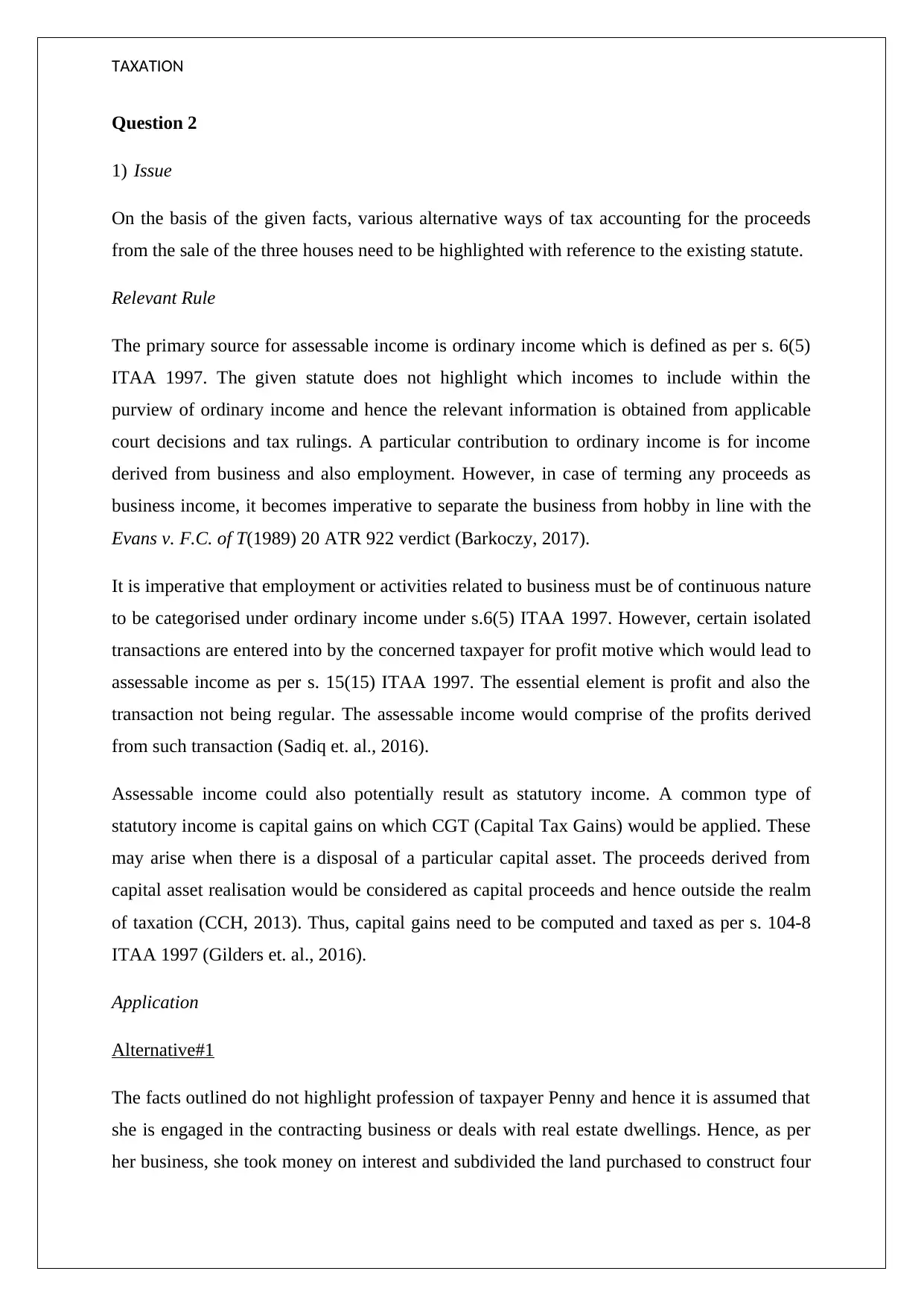
TAXATION
Question 2
1) Issue
On the basis of the given facts, various alternative ways of tax accounting for the proceeds
from the sale of the three houses need to be highlighted with reference to the existing statute.
Relevant Rule
The primary source for assessable income is ordinary income which is defined as per s. 6(5)
ITAA 1997. The given statute does not highlight which incomes to include within the
purview of ordinary income and hence the relevant information is obtained from applicable
court decisions and tax rulings. A particular contribution to ordinary income is for income
derived from business and also employment. However, in case of terming any proceeds as
business income, it becomes imperative to separate the business from hobby in line with the
Evans v. F.C. of T(1989) 20 ATR 922 verdict (Barkoczy, 2017).
It is imperative that employment or activities related to business must be of continuous nature
to be categorised under ordinary income under s.6(5) ITAA 1997. However, certain isolated
transactions are entered into by the concerned taxpayer for profit motive which would lead to
assessable income as per s. 15(15) ITAA 1997. The essential element is profit and also the
transaction not being regular. The assessable income would comprise of the profits derived
from such transaction (Sadiq et. al., 2016).
Assessable income could also potentially result as statutory income. A common type of
statutory income is capital gains on which CGT (Capital Tax Gains) would be applied. These
may arise when there is a disposal of a particular capital asset. The proceeds derived from
capital asset realisation would be considered as capital proceeds and hence outside the realm
of taxation (CCH, 2013). Thus, capital gains need to be computed and taxed as per s. 104-8
ITAA 1997 (Gilders et. al., 2016).
Application
Alternative#1
The facts outlined do not highlight profession of taxpayer Penny and hence it is assumed that
she is engaged in the contracting business or deals with real estate dwellings. Hence, as per
her business, she took money on interest and subdivided the land purchased to construct four
Question 2
1) Issue
On the basis of the given facts, various alternative ways of tax accounting for the proceeds
from the sale of the three houses need to be highlighted with reference to the existing statute.
Relevant Rule
The primary source for assessable income is ordinary income which is defined as per s. 6(5)
ITAA 1997. The given statute does not highlight which incomes to include within the
purview of ordinary income and hence the relevant information is obtained from applicable
court decisions and tax rulings. A particular contribution to ordinary income is for income
derived from business and also employment. However, in case of terming any proceeds as
business income, it becomes imperative to separate the business from hobby in line with the
Evans v. F.C. of T(1989) 20 ATR 922 verdict (Barkoczy, 2017).
It is imperative that employment or activities related to business must be of continuous nature
to be categorised under ordinary income under s.6(5) ITAA 1997. However, certain isolated
transactions are entered into by the concerned taxpayer for profit motive which would lead to
assessable income as per s. 15(15) ITAA 1997. The essential element is profit and also the
transaction not being regular. The assessable income would comprise of the profits derived
from such transaction (Sadiq et. al., 2016).
Assessable income could also potentially result as statutory income. A common type of
statutory income is capital gains on which CGT (Capital Tax Gains) would be applied. These
may arise when there is a disposal of a particular capital asset. The proceeds derived from
capital asset realisation would be considered as capital proceeds and hence outside the realm
of taxation (CCH, 2013). Thus, capital gains need to be computed and taxed as per s. 104-8
ITAA 1997 (Gilders et. al., 2016).
Application
Alternative#1
The facts outlined do not highlight profession of taxpayer Penny and hence it is assumed that
she is engaged in the contracting business or deals with real estate dwellings. Hence, as per
her business, she took money on interest and subdivided the land purchased to construct four
Paraphrase This Document
Need a fresh take? Get an instant paraphrase of this document with our AI Paraphraser
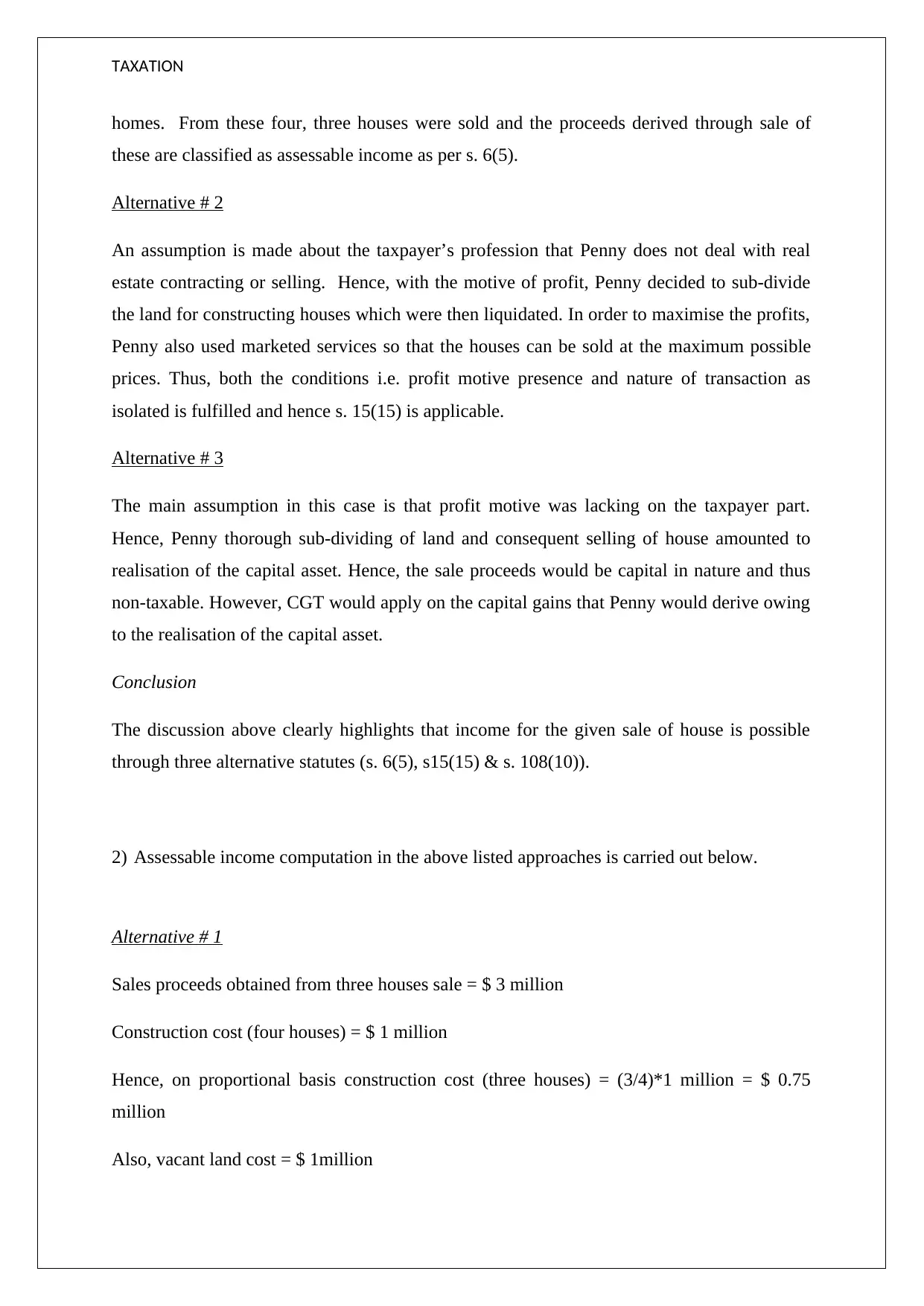
TAXATION
homes. From these four, three houses were sold and the proceeds derived through sale of
these are classified as assessable income as per s. 6(5).
Alternative # 2
An assumption is made about the taxpayer’s profession that Penny does not deal with real
estate contracting or selling. Hence, with the motive of profit, Penny decided to sub-divide
the land for constructing houses which were then liquidated. In order to maximise the profits,
Penny also used marketed services so that the houses can be sold at the maximum possible
prices. Thus, both the conditions i.e. profit motive presence and nature of transaction as
isolated is fulfilled and hence s. 15(15) is applicable.
Alternative # 3
The main assumption in this case is that profit motive was lacking on the taxpayer part.
Hence, Penny thorough sub-dividing of land and consequent selling of house amounted to
realisation of the capital asset. Hence, the sale proceeds would be capital in nature and thus
non-taxable. However, CGT would apply on the capital gains that Penny would derive owing
to the realisation of the capital asset.
Conclusion
The discussion above clearly highlights that income for the given sale of house is possible
through three alternative statutes (s. 6(5), s15(15) & s. 108(10)).
2) Assessable income computation in the above listed approaches is carried out below.
Alternative # 1
Sales proceeds obtained from three houses sale = $ 3 million
Construction cost (four houses) = $ 1 million
Hence, on proportional basis construction cost (three houses) = (3/4)*1 million = $ 0.75
million
Also, vacant land cost = $ 1million
homes. From these four, three houses were sold and the proceeds derived through sale of
these are classified as assessable income as per s. 6(5).
Alternative # 2
An assumption is made about the taxpayer’s profession that Penny does not deal with real
estate contracting or selling. Hence, with the motive of profit, Penny decided to sub-divide
the land for constructing houses which were then liquidated. In order to maximise the profits,
Penny also used marketed services so that the houses can be sold at the maximum possible
prices. Thus, both the conditions i.e. profit motive presence and nature of transaction as
isolated is fulfilled and hence s. 15(15) is applicable.
Alternative # 3
The main assumption in this case is that profit motive was lacking on the taxpayer part.
Hence, Penny thorough sub-dividing of land and consequent selling of house amounted to
realisation of the capital asset. Hence, the sale proceeds would be capital in nature and thus
non-taxable. However, CGT would apply on the capital gains that Penny would derive owing
to the realisation of the capital asset.
Conclusion
The discussion above clearly highlights that income for the given sale of house is possible
through three alternative statutes (s. 6(5), s15(15) & s. 108(10)).
2) Assessable income computation in the above listed approaches is carried out below.
Alternative # 1
Sales proceeds obtained from three houses sale = $ 3 million
Construction cost (four houses) = $ 1 million
Hence, on proportional basis construction cost (three houses) = (3/4)*1 million = $ 0.75
million
Also, vacant land cost = $ 1million
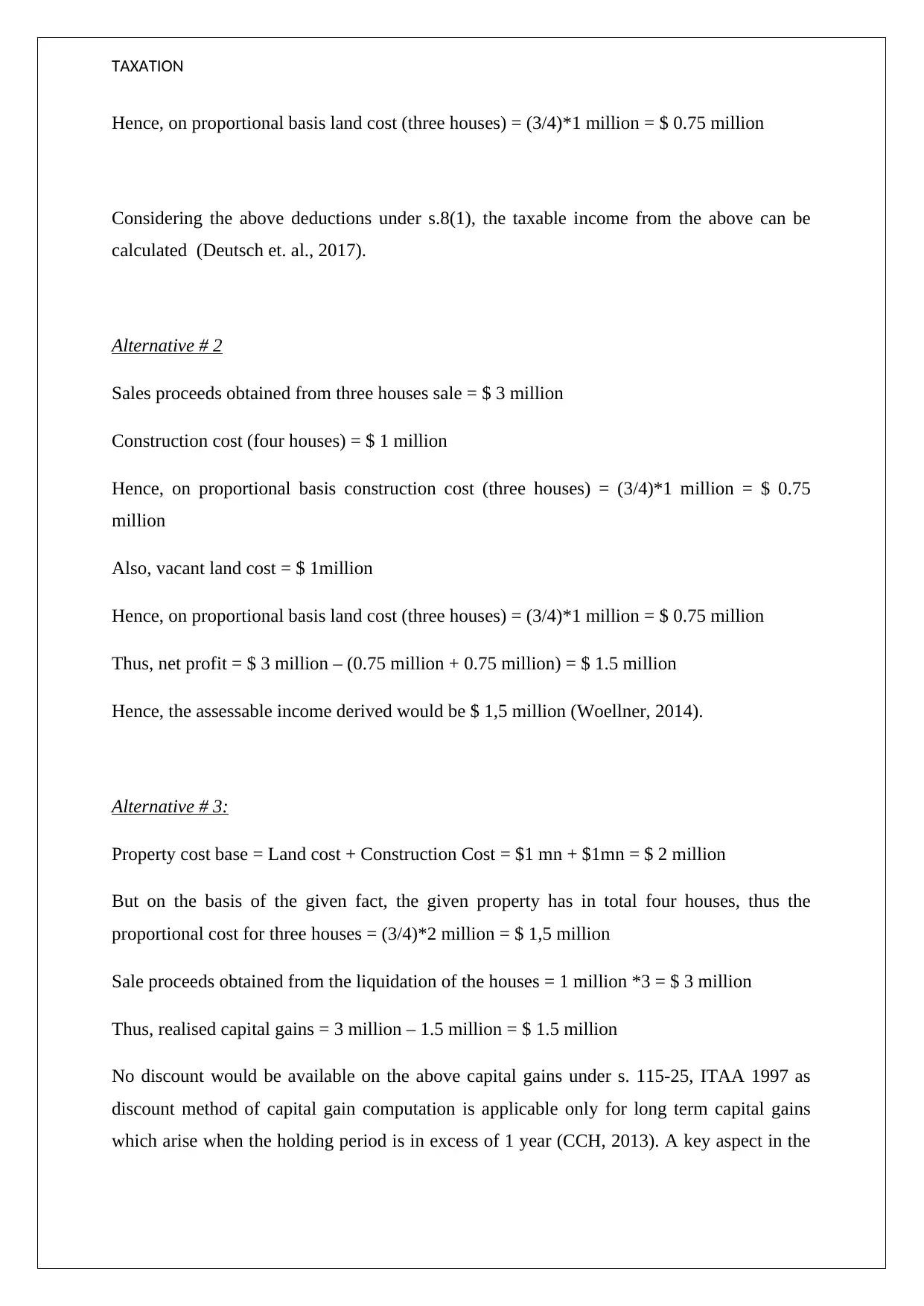
TAXATION
Hence, on proportional basis land cost (three houses) = (3/4)*1 million = $ 0.75 million
Considering the above deductions under s.8(1), the taxable income from the above can be
calculated (Deutsch et. al., 2017).
Alternative # 2
Sales proceeds obtained from three houses sale = $ 3 million
Construction cost (four houses) = $ 1 million
Hence, on proportional basis construction cost (three houses) = (3/4)*1 million = $ 0.75
million
Also, vacant land cost = $ 1million
Hence, on proportional basis land cost (three houses) = (3/4)*1 million = $ 0.75 million
Thus, net profit = $ 3 million – (0.75 million + 0.75 million) = $ 1.5 million
Hence, the assessable income derived would be $ 1,5 million (Woellner, 2014).
Alternative # 3:
Property cost base = Land cost + Construction Cost = $1 mn + $1mn = $ 2 million
But on the basis of the given fact, the given property has in total four houses, thus the
proportional cost for three houses = (3/4)*2 million = $ 1,5 million
Sale proceeds obtained from the liquidation of the houses = 1 million *3 = $ 3 million
Thus, realised capital gains = 3 million – 1.5 million = $ 1.5 million
No discount would be available on the above capital gains under s. 115-25, ITAA 1997 as
discount method of capital gain computation is applicable only for long term capital gains
which arise when the holding period is in excess of 1 year (CCH, 2013). A key aspect in the
Hence, on proportional basis land cost (three houses) = (3/4)*1 million = $ 0.75 million
Considering the above deductions under s.8(1), the taxable income from the above can be
calculated (Deutsch et. al., 2017).
Alternative # 2
Sales proceeds obtained from three houses sale = $ 3 million
Construction cost (four houses) = $ 1 million
Hence, on proportional basis construction cost (three houses) = (3/4)*1 million = $ 0.75
million
Also, vacant land cost = $ 1million
Hence, on proportional basis land cost (three houses) = (3/4)*1 million = $ 0.75 million
Thus, net profit = $ 3 million – (0.75 million + 0.75 million) = $ 1.5 million
Hence, the assessable income derived would be $ 1,5 million (Woellner, 2014).
Alternative # 3:
Property cost base = Land cost + Construction Cost = $1 mn + $1mn = $ 2 million
But on the basis of the given fact, the given property has in total four houses, thus the
proportional cost for three houses = (3/4)*2 million = $ 1,5 million
Sale proceeds obtained from the liquidation of the houses = 1 million *3 = $ 3 million
Thus, realised capital gains = 3 million – 1.5 million = $ 1.5 million
No discount would be available on the above capital gains under s. 115-25, ITAA 1997 as
discount method of capital gain computation is applicable only for long term capital gains
which arise when the holding period is in excess of 1 year (CCH, 2013). A key aspect in the
⊘ This is a preview!⊘
Do you want full access?
Subscribe today to unlock all pages.

Trusted by 1+ million students worldwide
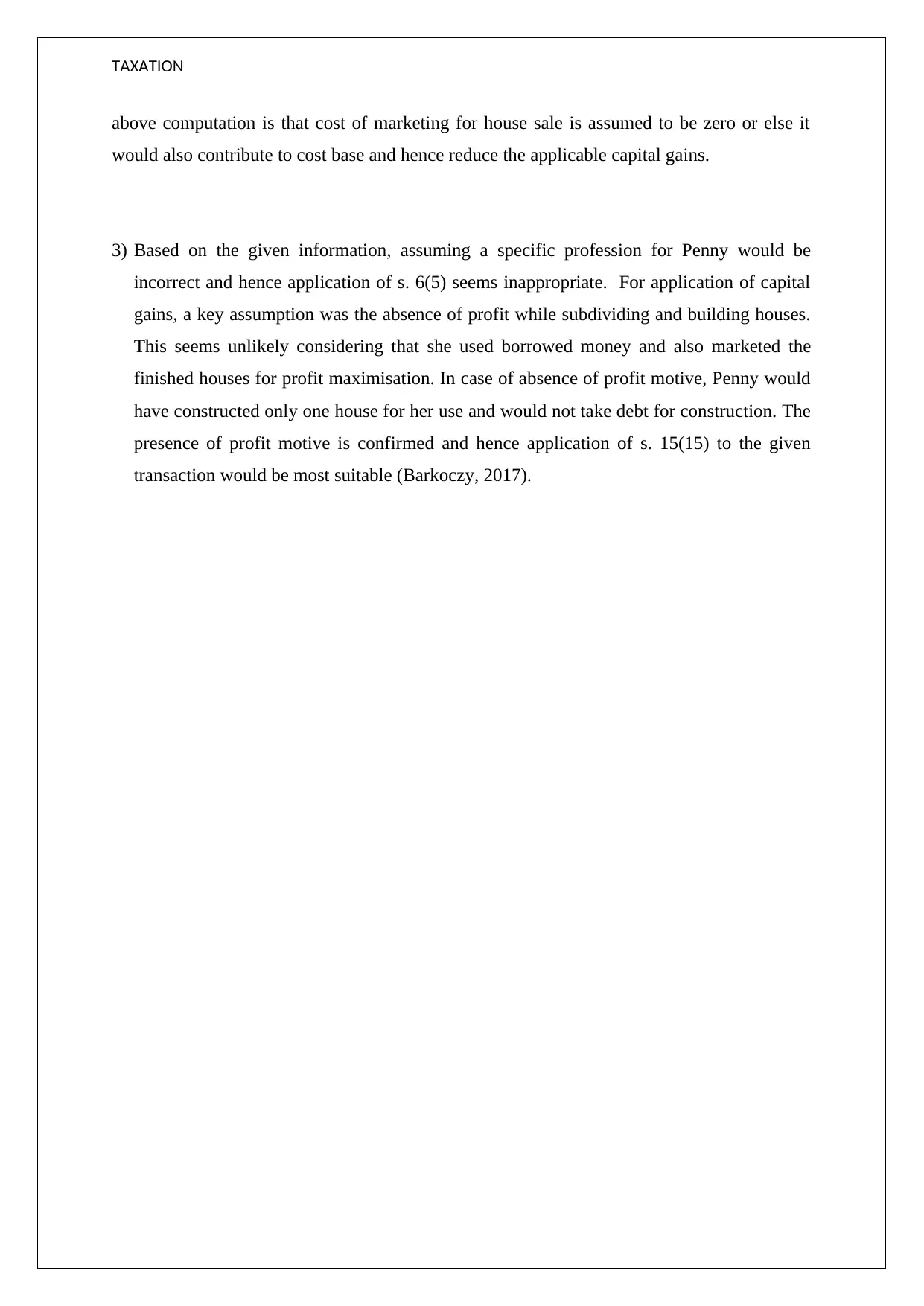
TAXATION
above computation is that cost of marketing for house sale is assumed to be zero or else it
would also contribute to cost base and hence reduce the applicable capital gains.
3) Based on the given information, assuming a specific profession for Penny would be
incorrect and hence application of s. 6(5) seems inappropriate. For application of capital
gains, a key assumption was the absence of profit while subdividing and building houses.
This seems unlikely considering that she used borrowed money and also marketed the
finished houses for profit maximisation. In case of absence of profit motive, Penny would
have constructed only one house for her use and would not take debt for construction. The
presence of profit motive is confirmed and hence application of s. 15(15) to the given
transaction would be most suitable (Barkoczy, 2017).
above computation is that cost of marketing for house sale is assumed to be zero or else it
would also contribute to cost base and hence reduce the applicable capital gains.
3) Based on the given information, assuming a specific profession for Penny would be
incorrect and hence application of s. 6(5) seems inappropriate. For application of capital
gains, a key assumption was the absence of profit while subdividing and building houses.
This seems unlikely considering that she used borrowed money and also marketed the
finished houses for profit maximisation. In case of absence of profit motive, Penny would
have constructed only one house for her use and would not take debt for construction. The
presence of profit motive is confirmed and hence application of s. 15(15) to the given
transaction would be most suitable (Barkoczy, 2017).
Paraphrase This Document
Need a fresh take? Get an instant paraphrase of this document with our AI Paraphraser
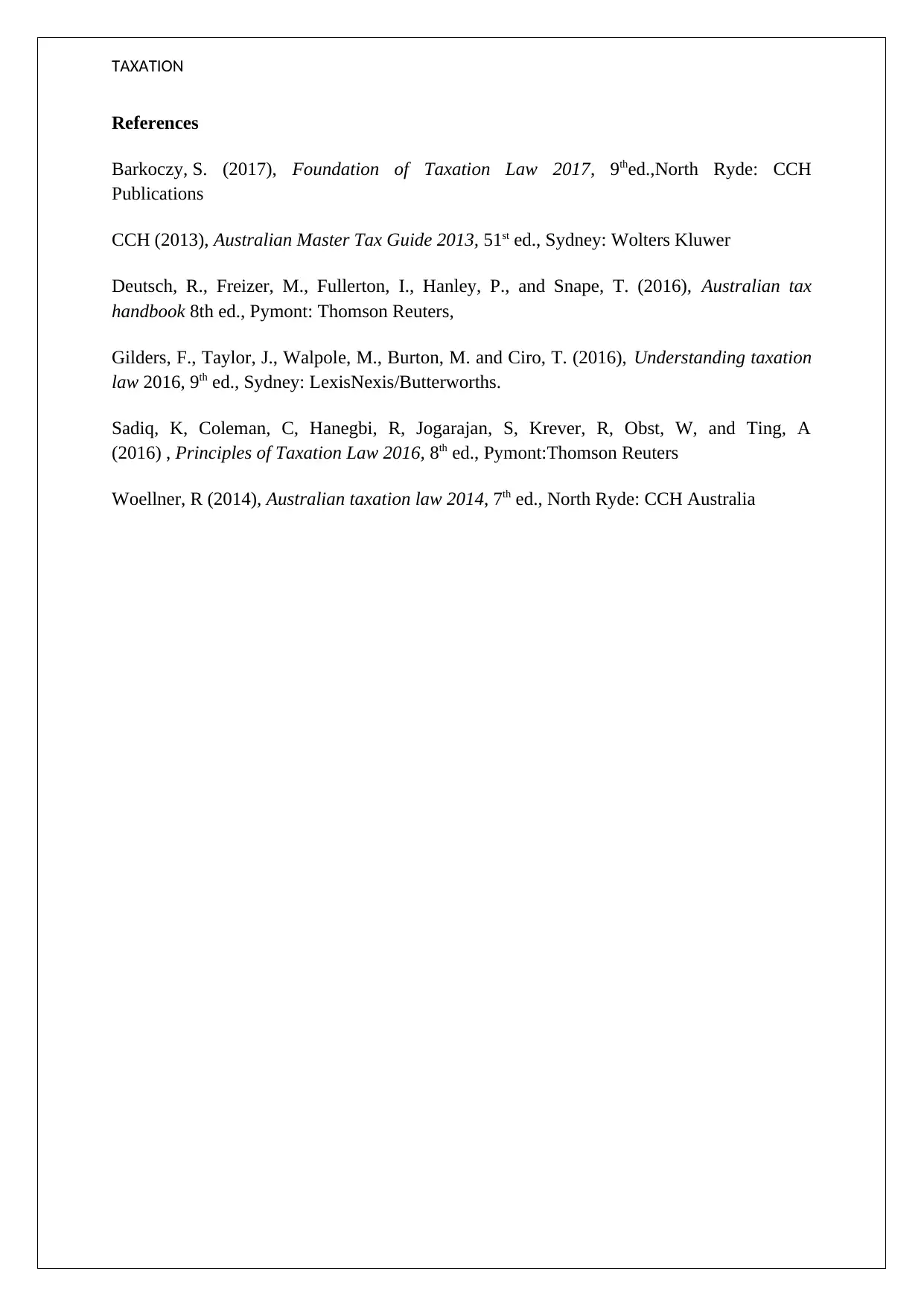
TAXATION
References
Barkoczy, S. (2017), Foundation of Taxation Law 2017, 9thed.,North Ryde: CCH
Publications
CCH (2013), Australian Master Tax Guide 2013, 51st ed., Sydney: Wolters Kluwer
Deutsch, R., Freizer, M., Fullerton, I., Hanley, P., and Snape, T. (2016), Australian tax
handbook 8th ed., Pymont: Thomson Reuters,
Gilders, F., Taylor, J., Walpole, M., Burton, M. and Ciro, T. (2016), Understanding taxation
law 2016, 9th ed., Sydney: LexisNexis/Butterworths.
Sadiq, K, Coleman, C, Hanegbi, R, Jogarajan, S, Krever, R, Obst, W, and Ting, A
(2016) , Principles of Taxation Law 2016, 8th ed., Pymont:Thomson Reuters
Woellner, R (2014), Australian taxation law 2014, 7th ed., North Ryde: CCH Australia
References
Barkoczy, S. (2017), Foundation of Taxation Law 2017, 9thed.,North Ryde: CCH
Publications
CCH (2013), Australian Master Tax Guide 2013, 51st ed., Sydney: Wolters Kluwer
Deutsch, R., Freizer, M., Fullerton, I., Hanley, P., and Snape, T. (2016), Australian tax
handbook 8th ed., Pymont: Thomson Reuters,
Gilders, F., Taylor, J., Walpole, M., Burton, M. and Ciro, T. (2016), Understanding taxation
law 2016, 9th ed., Sydney: LexisNexis/Butterworths.
Sadiq, K, Coleman, C, Hanegbi, R, Jogarajan, S, Krever, R, Obst, W, and Ting, A
(2016) , Principles of Taxation Law 2016, 8th ed., Pymont:Thomson Reuters
Woellner, R (2014), Australian taxation law 2014, 7th ed., North Ryde: CCH Australia
1 out of 5
Related Documents
Your All-in-One AI-Powered Toolkit for Academic Success.
+13062052269
info@desklib.com
Available 24*7 on WhatsApp / Email
![[object Object]](/_next/static/media/star-bottom.7253800d.svg)
Unlock your academic potential
Copyright © 2020–2025 A2Z Services. All Rights Reserved. Developed and managed by ZUCOL.





